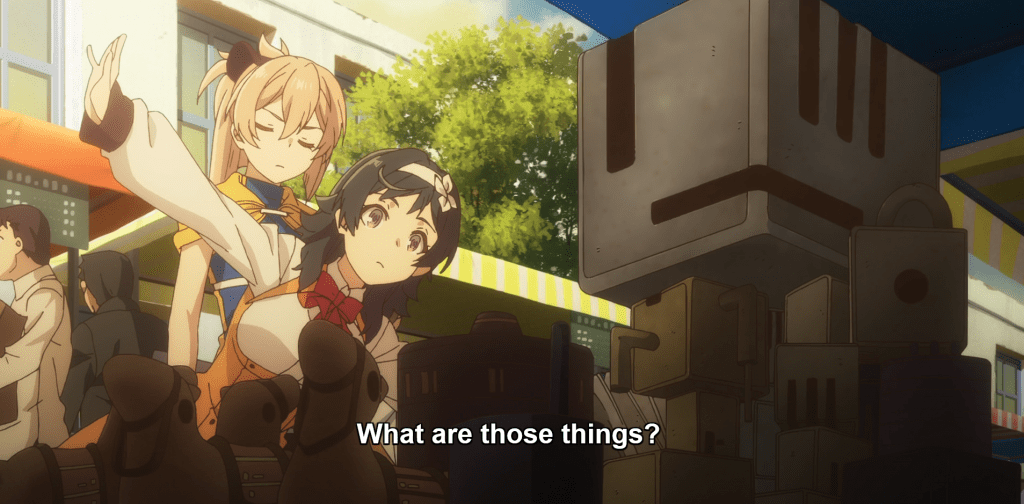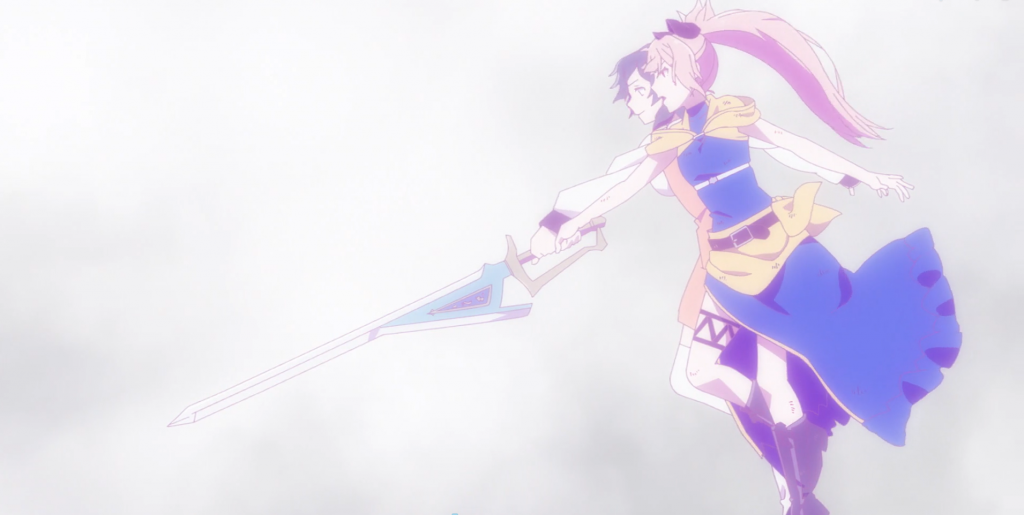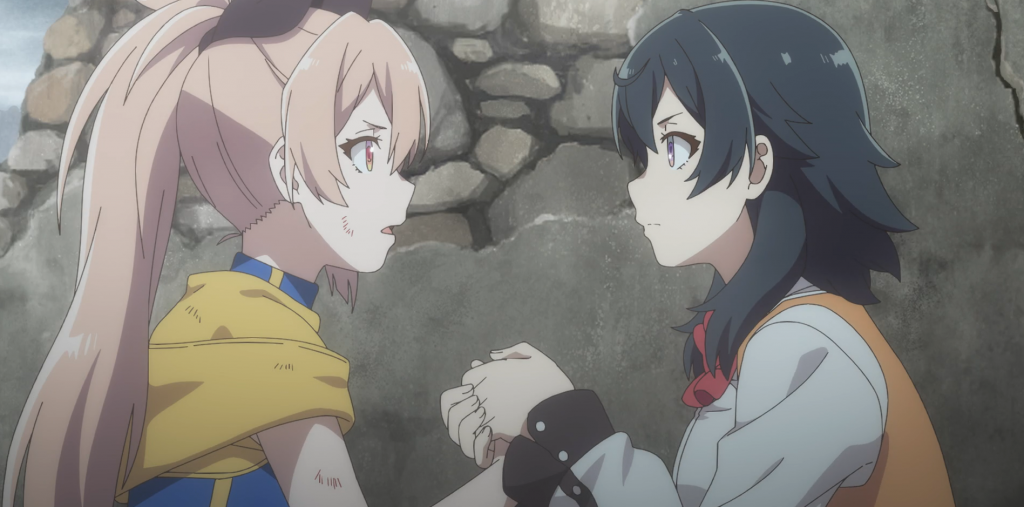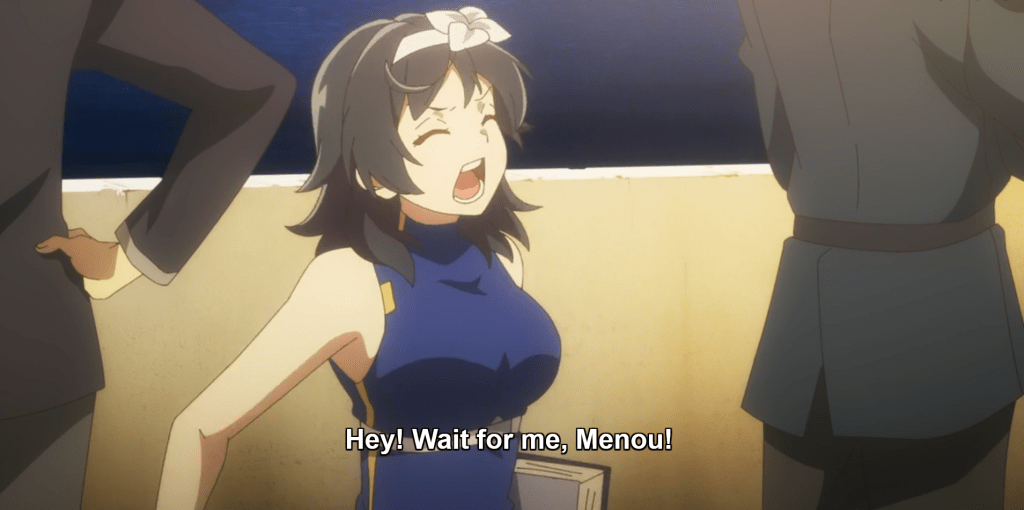“The Executioner and Her Way of Life”: An Exciting Yuri Isekai Series

On April 2, 2022, The Executioner and Her Way of Life premiered on HIDIVE. This series tells the story of an executioner named Menou tasked with killing a Japanese girl, Akari Tokitō, but not everything goes as planned…
The Executioner and Her Way of Life is a yuri isekai adventure series directed by Yoshiki Kawasaki and written by Shōgo Yasukawa. It is based on a manga and light novel of the same name by Mato Sato.
Trigger Warning: This post mentions sensitive topics such as bullying, murder, memory loss, and kidnapping
The first season of this exciting series began powerfully. The first seven episodes follow Menou (Iori Saeki) as she tries to kill Akari (voiced by Moe Kahara). Akari has the power to turn back time. She can revive herself if anyone tries to kill her. Menou works with her loyal aide, Momo (voiced by Hisako Kanemoto), who is jealous of how close Menou and Akari are getting. She gives Akari the nickname “booblicious”.
The remaining five episodes of this series continue the story with unexpected twists and turns. This includes the encroaching Pandæmonium (Anzu Haruno) and its monstrous manifestation in the port city of Libelle. All the while, a warrior princess, Ashuna (M・A・O) follows them. She has little regard for her noble status and wants to fight villains no matter what.
Akin to extreme bloodiness of episodes of The Legend of Vox Machina or fights in Helluva Boss, The Executioner and Her Way of Life becomes almost horror-like in its final arc. This includes the gruesome death of Manon Libelle (Manaka Iwami). Manon tries to defend herself by calling on strong magical powers. Pandæmonium, in the form of a sadistic little girl, replaces her.
This series is in no way for children. It is for mature adults. Scenes in later episodes could almost come out of nightmares. It goes far beyond any mature tone in all-ages animations like Amphibia or The Owl House by leaps and bounds.
The series is engaging and intriguing, but it leaves more questions than answers. The series only had a 12-episode run from April to June of this year. Even so, the final episode leaves the door open for a possible continuation. This post is filled with spoilers, so be warned.
Memories and Manipulation

The first seven episodes of The Executioner and Her Way of Life implied that Menou and Akari were friends in a previous life in Japan. The later episodes never clarify whether this is the case, but they do reveal a terrifying secret: any time that Akari uses her powers, she loses a memory. She loses a part of herself with each blast.
Pandæmonium taunts her with this reality and claims there is a way back to Japan. Akari rejects this. She reveals that she as a Japanese schoolgirl people bullied her. Unsurprisingly, she has no desire to return.
Later, Pandæmonium declares that someone is repeatedly causing her efforts, to make Menou kill her, fail. She realizes that Menou’s former master, Flare, is the culprit. Even worse is the fact that her do-overs caused Pandæmonium to leave the enveloping fog. Once outside, she terrorizes the city and almost kills the woman she loves, Menou.
Every time she does a do-over, and sees Menou die, her regression gets worse. She no longer has a connection to the Astral Archive, which stores memories of the planet and its powers.
Her memory loss is not as severe as Kaede’s two-year-long amnesia in Rascal Does Not Dream of Bunny Girl Senpai. In this series, it is not known whether Akari’s memories are permanently deleted or are just inaccessible.
What Akari experiences is different from possible human experimentation on Eve, a protagonist of Birdie Wing: A Golf Girls Story. Flare is toying with Akari and repeatedly causing her anguish. Perhaps to protect herself from the mounting trauma, and near-death of Menou, she uses her powers to wipe her memory of the events.
In a possible second season, mind manipulation and destruction-prone tactics of Pandæmonium would be even worse. In the final episode, one of her fragments survives and makes an alliance with Manon to bring chaos to the world.
Bursting with Yuri
The series goes beyond being a yuri isekai about an assassin trying to kill those from another world. The plot and the characters are filled with yuri. First is the budding romance between Akari and Menou.
Reviewers like Vrai Kaiser have a point about Momo as a “stereotypical handsy stalker type” who worships Menou. I would slightly counter Kaiser’s argument. When Akari enters the picture, Momo restrains herself to an extent. Even when she doesn’t, Menou isn’t the biggest fan of Momo fawning over her. She just wants to get her job done and execute Akari.
Momo’s actions are not as extreme as the stalkery fan in Carole & Tuesday, a series with poor LGBTQ representation. It differs from Haruka Nishida in Kanameno with a fetish for underage girls and more like the cute yuri couple in the same series.

By the end of the first season of The Executioner and Her Way of Life, Menou considers whether she could neutralize the threat that Akari causes by allowing her to live. Such a possibility would go against everything she believes as an executioner.
Menou is slowly falling in love with Akari. The opposite is the case for Akari, who is head over heels in love with Menou. As for Menou, she slowly shows signs that she may have feelings for Akari. Both of them tour the cities of Garm and Libelle together, in what could be called dates. Another season could focus more on their growing affections for one another.
Predictably, Momo wants Akari out of the picture and even vows to kill Akari herself, so she can have Menou to herself. Little does she know that Akari helped heal her by using her power to move back time!
In terms of yuri themes, it is just as strong as the little-known sci-fi yuri drama, Blue Drop, or the well-known yuri romance, Bloom Into You. This series is different from those, in terms of being a compelling yuri fantasy. It is also more overt than more mature anime like Otherside Picnic with yuri themes so diluted that they became meaningless.
Although there are occasional bouts of fanservice in The Executioner and Her Way of Life, it is nothing to the level of many other anime. For instance, yuri anime, such as Flip Flappers, Valkyrie Drive, and Mnemosyne, have more fanservice.
A Unique Isekai
The focus on yuri makes this series fundamentally different from other novels and anime about those who end up in another world. Often, girls are reincarnated in another world and draw attention from physically attractive men. This includes My Next Life as a Villainess: All Routes Lead to Doom!, about a girl who begins a new life as a villainess in an otome game she once played.
The Executioner and Her Way of Life explores the seemingly infinite possibilities of the isekai genre with a fascinating story. While it doesn’t have the social commentary on overwork that series like the soon-to-be returning I’ve Been Killing Slimes for 300 Years and Maxed Out My Level, to give one example, it does provide social commentary. In the show’s later episode, there is a focus on yuri horror and the sick plans of Pandæmonium. This could be interpreted as a criticism of the horror genre and how gruesome it can get at times.
At the same time, there is the inevitable clash of cultures, of the world Akari comes from and the world that Menou lives in. There are no themes of those disillusioned with their previous lives or have their genders transformed like in Life with an Ordinary Guy Who Reincarnated into a Total Fantasy Knockout.
Rather, it has magic and religious themes, making it different from other isekai which involve travelers from Japan, like the 1990s El-Hazard series, with one OVA even featuring a lesbian relationship. Some reviewers called the series an “answer” to the trend of isekai, terming Akari and Menou as “murder wives”, and noting the show’s “exaggerated approach to the genre” which is full-on gay.

The series focuses on the common theme: power can corrupt absolutely. This is shown, in later episodes, through Manon’s attempt to defeat Menou by using “taboo” powers and even sacrificing herself to bring the Pandæmonium into existence. Earlier episodes demonstrate this through the sadistic plan by Archbishop Orwell (Tamie Kubota) to kidnap young girls in hopes of making her more youthful.
The parallel world of The Executioner and Her Way of Life is different from another other series I’ve seen. There isn’t a science fiction element though the series fall into the common stereotypes for the genre. Rather, it combines the best elements of yuri stories with the best ones in isekai. Although the series has monsters, it is not based on or akin to a video game. Instead, it is a mix of romance, adventure, and suspense.
The series also differs from Western animation which involves dimensional travel. Although Akari can be goofy and aloof at times, the characters are much more mature than the teenage protagonists of The Owl House and Amphibia. There are also scenes with drowning, poisoning, grievous injury, and the like, going beyond even the most mature moments of the latter two series.
The Executioner and Her Way of Life does, however, have some similarities with Samurai Jack, in that the characters are on a journey, a quest, and face challenges along the way. As mentioned earlier, trauma is a major component of this series. It informs the actions of Manon, while everyone else has traumatic experiences over and over throughout the series.
Talented Cast and Crew
The amazing animation by J.C. Staff and background art isn’t complete without the amazing voices, directors, and everyone working on the show. Some names were familiar to me, like M・A・O, who is also known as Mao Ichimichi. As it turns out, this year alone she voiced characters in thirteen anime series.
The same is the case for other voice actors in the series. Hisaki Kanemoto, who also voiced a character in Love After World Domination, voiced characters in the wonderful sci-fi adventure, Bodacious Space Pirates, and the second season of The Demon Girl Next Door. Iori Saeki has just as many voice credits, lending her voice to characters in Adachi and Shimamura, and in the upcoming Tokyo Mew Mew New. Yuma Uchida is also voicing a character in the latter series, and another in Heroines Run the Show.
Other voice actors lent their voices to characters in series such as Spy × Family, Yamibou, Strawberry Panic!, Gargantia on the Verdurous Planet, B Gata H Kei, and many others. Many of these anime are yuri or have yuri themes, which gave them something to build on in The Executioner and Her Way of Life.
Those directing and supervising the series are just as skilled. Some have worked on the fantasy isekai series, Ascendance of a Bookworm, while others have worked on other series like the romantic drama yaoi, Given.
Looking Toward a Second Season
Although this series may be, like too many anime, a solitary season, there are many areas for expansion. For one, there are colonialist undercurrents in a society comprised of commoners, evil nobles, and priests, as one reviewer pointed out. In my original review of the series, I noted the same, noting that the world is Japanese-influenced and split into various classes.
Another season would continue the romance of Akari and Menou. All the while Momo remains jealous, even trying to kill Akari if she gets the chance. This could cause Menou and Momo to compete with one another, deciding who will kill Akari first.
On the other hand, Akari, Menou, Momo, and even Ashuna, may have to put their differences aside and come together to fight a common threat. This could be Flare, or the combined evil of Pandæmonium and Manon. Another season could focus more on the family of Manon and the troubled life of Akari back in Japan. Both are briefly touched on in this season.
The series could further focus on the origin of the “pure concepts”, magical powers which offworlders have, and how their powers work. So far, the series has delved a bit into this, and talks about the “great human errors” which attempted to ruin the world in the past, but further focus could make the series even more compelling.
There could also be a focus on the role of religion in society and the power of the church. This is a major theme of the series, but another season could do it more justice.
Closing Words
Hopefully, the series improves in the second season, with stronger storylines, characters, and more unified tone. The tonal change of the series in the last few episodes to almost yuri horror was a bit jarring.
The success of this series will likely inform future yuri series by J.C. Staff and others on HIDIVE. In the end, while I have my criticisms of the series, I look forward to seeing where it goes in a second season, and beyond.
The Executioner and Her Way of Life can be watched on HIDIVE.
Author: Burkely Hermann
Burkely is an indexer of declassified documents by day and a fan fic writer by night. He recently earned a MLIS with a concentration in Digital Curation from the University of Maryland. He currently voraciously watches animated series and reads too many webcomics to count on Webtoon. He loves swimming, hiking, and searching his family roots in his spare time.
Help support independent journalism. Subscribe to our Patreon.
Copyright © The Geekiary
Do not copy our content in whole to other websites. If you are reading this anywhere besides TheGeekiary.com, it has been stolen.Read our







1 thought on ““The Executioner and Her Way of Life”: An Exciting Yuri Isekai Series”
Comments are closed.